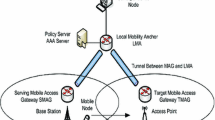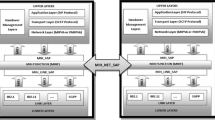Abstract
Seamless inter-technology mobility is one of the fundamental requirements of next generation mobile networks. For seamless mobility, handover delay and packet loss should be minimized. However, existing solutions suffer from a number of shortcomings in satisfying these requirements: first, handover preparation schemes fail to minimize the handover delay as much as possible. Second, minimizing packet loss which is usually using soft handover (SHO) schemes are excessively wasteful of scarce resources. In this paper, we propose the uninterrupted proactive connection transfer for IMS mobility enhancement (UPTIME) mobility framework which achieves seamless mobility while minimizing excessive power and radio resource consumption. UPTIME incorporates two mechanisms; a proactive handover preparation method and an optimized SHO technique for handover execution. We demonstrate the benefits of the proposed framework through both analysis and simulation. Our simulation results for typical LTE/WiMAX handovers show that the handover preparation delay can be reduced by 70 %, and good packet loss performance can be achieved whilst saving 43 % of radio resources and 48 % of battery power.












Similar content being viewed by others
References
3GPP. (2010). 3G security; Access security for IP-based services. TS 33203 Release 9.
3GPP. (2010). 3GPP system architecture evolution (SAE); Security aspects of non-3GPP accesses. TS 33402 Release 9.
3GPP. (2010). IP multimedia subsystem (IMS) stage 2. TS 23228 (Release 8).
3GPP. (2011). General packet radio service (GPRS) enhancements for evolved universal terrestrial radio access network (E-UTRAN) access. TS 23401 (Release 9).
3GPP. (2011). IP multimedia subsystem (IMS) service continuity; Stage 2. TS 23237 0 (Release 10).
Akyildiz, I., & Wang, W. (2004). The predictive user mobility profile framework for wireless multimedia networks. IEEE/ACM Transactions on Networking, 12(6), 1021–1035.
Ciubotaru, B., & Muntean, G. M. (2009). SASHA—A quality-oriented handover algorithm for multimedia content delivery to mobile users. IEEE Transactions on Broadcasting, 55(2), 437–450.
Dutta, A., Famolari, D., Das, S., Ohba, Y., Fajardo, V., Taniuchi, K., et al. (2008). Media-independent pre-authentication supporting secure interdomain handover optimization. IEEE Wireless Communications, 15(2), 55–64.
Huang, J., Feng, R., Bi, Y., Wu, J., & Song, M. (2005). A IP layer soft-handover approach for all-IP wireless wetworks. In 2nd international conference on mobile technology, applications and systems, pp. 1–4.
IEEE. (2009). IEEE standard for local and metropolitan area networks—Media independent handover services. IEEE Standard 80221.
Ito, M., Komorita, S., Chiba, T., Kitatsuji, Y., & Yokota, H. (2010). On IMS-based fast session handover based on available network resources of access networks. In IEEE 6th international conference on wireless and mobile communications, pp. 78–85.
ITU-R. (2000). Guidelines for evaluation of radio transmission technologies for IMT-2000 (pp. 1–61). ITU-R M1225 2000.
ITU-T (2004). General overview of NGN. ITU-T Recommendation Y2001.
ITU-T. (2006). Mobility management requirements for NGN. ITU-T Recommendation Y2801.
Kibria, M., & Jamalipour, A. (2007). On designing issues of the next generation mobile network. IEEE Network, 21(1), 6–13.
Lin, H. P., & Tseng, M. J. (2004). Two-level, multistate Markov model for satellite propagation channels. IEEE Proceedings Microwaves, Antennas and Propagation, 151(3), 241–248.
Melnyk, M., Jukan, A., & Polychronopoulos, C. (2007). A cross-layer analysis of session setup delay in IP Multimedia Subsystem (IMS) with EV-DO wireless transmission. IEEE Transactions on Multimedia, 9(4), 869–881.
Munir, A., & Gordon-Ross, A. (2010). SIP-based IMS signaling analysis for WiMax-3G interworking architectures. IEEE Transactions on Mobile Computing, 9(5), 733–750.
Nagaraj, S., Garg, S., Liang, F., Yang, W., Mangalvedhe, N., Haug, J., & Pradap, K. V. (2009). Lab performance analysis of a 4G LTE prototype. In IEEE wireless communications and networking conference (WCNC 2009), pp. 1–6.
Nazari, A., Branch, P., But, J., & Vu, H. L. (2010). Conservative soft handoff for heterogeneous wireless networks. In IEEE wireless communication and networking conference, pp. 1–6.
Nazari, A., But, J., Branch, P., & Vu, H. (2012). PRIME: Pre-registration for IMS mobility enhancement. In IEEE international conference on multimedia and expo, pp. 920–924.
Alliance, N. G. M. N. (2006). Next generation mobile networks beyond HSPA and EvDo. White paper, Next Generation Mobile Networks Ltd.
Park, A., Park, J., Kang, S., & Choi, J. (2008). Soft handover mechanism for IPTV service over wireless networks. In IEEE 10th international conference on advanced communication technology (ICACT 2008), vol. 2, pp. 1318–1320.
Renier, T., Larsen, K., & Castro, G. (2007). Mid-session macro-mobility in IMS-based networks. Vehicular Technology Magazine, 2(1), 20–27.
WiMAX Forum. (2010). Architecture tenets, reference model and reference points-base specification. WMF-T32-001-R015v02.
WiMAX Forum. (2011). Architecture, detailed protocols and procedures policy and charging control. WMF-T33-109-R015v03.
Yi-Bing, L., Ming-Feng, C., Meng-Ta, H., & Lin-Yi, W. (2005). One-pass GPRS and IMS authentication procedure for UMTS. IEEE Journal on Selected Areas in Communications, 23(6), 1233–1239.
Zaggoulos, G., Tran, M., & Nix, A. (2008). Mobile WiMAX system performance-simulated versus experimental results. In IEEE 19th international symposium on personal, indoor and mobile radio communications (PIMRC 2008), pp. 1–5.
Author information
Authors and Affiliations
Corresponding author
Appendix: Proof for given formulae
Appendix: Proof for given formulae
In this appendix we prove formula (20). The probability of being in state \(S_{ij}\) and using IF1 at time k + 1, denoted by \(IF_{1}[k+1],\) can be found as:
In other words, the probability of using IF1 being in state \(S_{ij}\) can be found by noting (1) The MS continues using IF1 if no handover happens in the previous state, and (2) A handover to IF1 only happens in states \(S_{41}\hbox { and }S_{42}.\)
Equation (28) can be rewritten as:
In the steady state condition we can write:
Using the definition of \(\psi _{1}^{ij},\) we have:
Using same approach we can derive (21) for IF2.
Rights and permissions
About this article
Cite this article
Nazari, A., Branch, P., But, J. et al. UPTIME: an IMS-based mobility framework for next generation mobile networks. Wireless Netw 20, 1967–1979 (2014). https://doi.org/10.1007/s11276-014-0717-y
Published:
Issue Date:
DOI: https://doi.org/10.1007/s11276-014-0717-y




